Peak Spring Flood Discharge Magnitude and Timing in Natural Rivers across Northern Finland: Long-Term Variability, Trends, and Links to Climate Teleconnections
Abstract
1. Introduction
2. Materials and Methods
2.1. Study Area
2.2. Data Description
2.3. Statistical Analyses
3. Results
4. Discussion
4.1. Peak Spring Flood Discharge Magnitude and Timing
4.2. Changes in Wintertime Snowpack Accumulation and Melt Processes
4.3. The Role of Climate Teleconnections
5. Conclusions
Author Contributions
Funding
Institutional Review Board Statement
Informed Consent Statement
Data Availability Statement
Acknowledgments
Conflicts of Interest
References
- IPCC; Masson-Delmotte, V.; Zhai, P.; Pirani, A.; Connors, S.L.; Péan, C.; Berger, S.; Caud, N.; Chen, Y.; Goldfarb, L.; et al. Climate Change 2021: The Physical Science Basis. Contribution of Working Group I to the Sixth Assessment Report of the Intergovernmental Panel on Climate Change; IPCC: Geneva, Switzerland, 2021. [Google Scholar]
- Iz, H.B. Is the Global Sea Surface Temperature Rise Accelerating? Geod. Geodyn. 2018, 9, 432–438. [Google Scholar] [CrossRef]
- Konapala, G.; Mishra, A.K.; Wada, Y.; Mann, M.E. Climate Change Will Affect Global Water Availability through Compounding Changes in Seasonal Precipitation and Evaporation. Nat. Commun. 2020, 11, 3044. [Google Scholar] [CrossRef] [PubMed]
- Berghuijs, W.R.; Larsen, J.R.; van Emmerik, T.H.M.; Woods, R.A. A Global Assessment of Runoff Sensitivity to Changes in Precipitation, Potential Evaporation, and Other Factors. Water Resour. Res. 2017, 53, 8475–8486. [Google Scholar] [CrossRef]
- AghaKouchak, A.; Chiang, F.; Huning, L.S.; Love, C.A.; Mallakpour, I.; Mazdiyasni, O.; Moftakhari, H.; Papalexiou, S.M.; Ragno, E.; Sadegh, M. Climate Extremes and Compound Hazards in a Warming World. Annu. Rev. Earth Planet. Sci. 2020, 48, 519–548. [Google Scholar] [CrossRef]
- Hugelius, G.; Loisel, J.; Chadburn, S.; Jackson, R.B.; Jones, M.; MacDonald, G.; Marushchak, M.; Olefeldt, D.; Packalen, M.; Siewert, M.B.; et al. Large Stocks of Peatland Carbon and Nitrogen Are Vulnerable to Permafrost Thaw. Proc. Natl. Acad. Sci. USA 2020, 117, 20438–20446. [Google Scholar] [CrossRef] [PubMed]
- Gudmundsson, L.; Boulange, J.; Do, H.X.; Gosling, S.N.; Grillakis, M.G.; Koutroulis, A.G.; Leonard, M.; Liu, J.; Schmied, H.M.; Papadimitriou, L.; et al. Globally Observed Trends in Mean and Extreme River Flow Attributed to Climate Change. Science 2021, 371, 1159–1162. [Google Scholar] [CrossRef]
- Barnett, T.P.; Adam, J.C.; Lettenmaier, D.P. Potential Impacts of a Warming Climate on Water Availability in Snow-Dominated Regions. Nature 2005, 438, 303–309. [Google Scholar] [CrossRef]
- Jansson, P.; Hock, R.; Schneider, T. The Concept of Glacier Storage: A Review. J. Hydrol. 2003, 282, 116–129. [Google Scholar] [CrossRef]
- Wilson, D.; Hisdal, H.; Lawrence, D. Has Streamflow Changed in the Nordic Countries?—Recent Trends and Comparisons to Hydrological Projections. J. Hydrol. 2010, 394, 334–346. [Google Scholar] [CrossRef]
- Pohl, S.; Marsh, P.; Bonsal, B.R. Modeling the Impact of Climate Change on Runoff and Annual Water Balance of an Arctic Headwater Basin. Arctic 2009, 60, 173–186. [Google Scholar] [CrossRef]
- Kivinen, S.; Kaarlejärvi, E.; Jylhä, K.; Räisänen, J. Spatiotemporal Distribution of Threatened High-Latitude Snowbed and Snow Patch Habitats in Warming Climate. Environ. Res. Lett. 2012, 7, 34024. [Google Scholar] [CrossRef]
- Kivinen, S.; Rasmus, S. Observed Cold Season Changes in a Fennoscandian Fell Area over the Past Three Decades. Ambio 2015, 44, 214–225. [Google Scholar] [CrossRef] [PubMed]
- Irannezhad, M.; Ronkanen, A.-K.; Kløve, B. Wintertime Climate Factors Controlling Snow Resource Decline in Finland. Int. J. Climatol. 2016, 36, 110–131. [Google Scholar] [CrossRef]
- Barnett, T.P.; Pierce, D.W.; Hidalgo, H.G.; Bonfils, C.; Santer, B.D.; Das, T.; Bala, G.; Wood, A.W.; Nozawa, T.; Mirin, A.A.; et al. Human-Induced Changes in the Hydrology of the Western United States. Science 2008, 319, 1080–1083. [Google Scholar] [CrossRef]
- Steele-Dunne, S.; Lynch, P.; McGrath, R.; Semmler, T.; Wang, S.; Hanafin, J.; Nolan, P. The Impacts of Climate Change on Hydrology in Ireland. J. Hydrol. 2008, 356, 28–45. [Google Scholar] [CrossRef]
- Okkonen, J.; Kløve, B. A Conceptual and Statistical Approach for the Analysis of Climate Impact on Ground Water Table Fluctuation Patterns in Cold Conditions. J. Hydrol. 2010, 388, 1–12. [Google Scholar] [CrossRef]
- Räisänen, J. Warmer Climate: Less or More Snow? Clim. Dyn. 2008, 30, 307–319. [Google Scholar] [CrossRef]
- Irannezhad, M.; Ronkanen, A.-K.; Kløve, B. Effects of Climate Variability and Change on Snowpack Hydrological Processes in Finland. Cold Reg. Sci. Technol. 2015, 118, 14–29. [Google Scholar] [CrossRef]
- Lau, N.C. Teleconnections Linking Worldwide Climate Anomalies: Scientific Basis and Societal Impact; Glantz, M.H., Katz, R., Nicholls, N., Eds.; Cambridge University Press: Cambridge, UK, 2009; ISBN 9780521106849 0521106842. [Google Scholar]
- Chen, D.; Chen, Y. Association between Winter Temperature in China and Upper Air Circulation over East Asia Revealed by Canonical Correlation Analysis. Glob. Planet. Chang. 2003, 37, 315–325. [Google Scholar] [CrossRef]
- Bartolini, E.; Claps, P.; D’Odorico, P. Connecting European Snow Cover Variability with Large Scale Atmospheric Patterns. Adv. Geosci. 2010, 26, 93–97. [Google Scholar] [CrossRef]
- Ghasemifar, E.; Irannezhad, M.; Minaei, F.; Minaei, M. The Role of ENSO in Atmospheric Water Vapor Variability during Cold Months over Iran. Theor. Appl. Climatol. 2022, 148, 795–817. [Google Scholar] [CrossRef]
- Hoy, A.; Sepp, M.; Matschullat, J. Large-Scale Atmospheric Circulation Forms and Their Impact on Air Temperature in Europe and Northern Asia. Theor. Appl. Climatol. 2013, 113, 643–658. [Google Scholar] [CrossRef]
- Irannezhad, M.; Liu, J. Evaluation of Six Gauge-Based Gridded Climate Products for Analyzing Long-Term Historical Precipitation Patterns Across the Lancang-Mekong River Basin. Geogr. Sustain. 2022, 3, 85–103. [Google Scholar] [CrossRef]
- Wang, H.; Chen, Y.; Li, W. Characteristics in Streamflow and Extremes in the Tarim River, China: Trends, Distribution and Climate Linkage. Int. J. Climatol. 2015, 35, 761–776. [Google Scholar] [CrossRef]
- Stewart, I.T.; Cayan, D.R.; Dettinger, M.D. Changes toward Earlier Streamflow Timing across Western North America. J. Clim. 2005, 18, 1136–1155. [Google Scholar] [CrossRef]
- Irannezhad, M.; Marttila, H.; Chen, D.; Kløve, B. Century-Long Variability and Trends in Daily Precipitation Characteristics at Three Finnish Stations. Adv. Clim. Chang. Res. 2016, 7, 54–69. [Google Scholar] [CrossRef]
- Irannezhad, M.; Chen, D.; Kløve, B. The Role of Atmospheric Circulation Patterns in Agroclimate Variability in Finland, 1961–2011. Geogr. Ann. Ser. A Phys. Geogr. 2016, 98, 287–301. [Google Scholar] [CrossRef]
- Kiani, S.; Irannezhad, M.; Ronkanen, A.-K.; Moradkhani, H.; Kløve, B. Effects of Recent Temperature Variability and Warming on the Oulu-Hailuoto Ice Road Season in the Northern Baltic Sea. Cold Reg. Sci. Technol. 2018, 151, 1–8. [Google Scholar] [CrossRef]
- Rödel, R. Varying Spatial Patterns of Trend and Seasonality in Eurasian Runoff Time Series. Adv. Geosci. 2006, 9, 93–100. [Google Scholar] [CrossRef][Green Version]
- Irannezhad, M. Effects of Temperature Variability and Warming on the Timing of Snowmelt Events in Southern Finland during the Past 100 Years. Reg.-Water Conserv. 2020, 3. [Google Scholar] [CrossRef]
- Fritze, H.; Stewart, I.T.; Pebesma, E. Shifts in Western North American Snowmelt Runoff Regimes for the Recent Warm Decades. J. Hydrometeorol. 2011, 12, 989–1006. [Google Scholar] [CrossRef]
- Irannezhad, M.; Ahmadi, B.; Liu, J.; Chen, D.; Matthews, J.H. Global Water Security: A Shining Star in the Dark Sky of Achieving the Sustainable Development Goals. Sustain. Horizons 2022, 1, 100005. [Google Scholar] [CrossRef]
- United Nations. About the Sustainable Development Goals-United Nations Sustainable Development. In Sustainable Development Goals; United Nations: New York, NY, USA, 2015. [Google Scholar]
- De Castro, M.; Gallardo, C.; Jylha, K.; Tuomenvirta, H. The Use of a Climate-Type Classification for Assessing Climate Change Effects in Europe from an Ensemble of Nine Regional Climate Models. Clim. Chang. 2007, 81, 329–341. [Google Scholar] [CrossRef]
- Käyhkö, J. Muuttuuko Pohjolan Ilmasto? (Fennoscandian Climate in Change?); Geography Department of the University of Turku: Turku, Finland, 2004; Volume 168, pp. 19–35. [Google Scholar]
- Irannezhad, M.; Marttila, H.; Kløve, B. Long-Term Variations and Trends in Precipitation in Finland. Int. J. Climatol. 2014, 34, 3139–3153. [Google Scholar] [CrossRef]
- Irannezhad, M.; Chen, D.; Kløve, B. Interannual Variations and Trends in Surface Air Temperature in Finland in Relation to Atmospheric Circulation Patterns, 1961–2011. Int. J. Climatol. 2015, 35, 3078–3092. [Google Scholar] [CrossRef]
- Pirinen, P.; Simola, H.; Aalto, J.; Kaukoranta, J.P.; Karlsson, P.; Ruuhela, R. Tilastoja Suomen Ilmastosta 1981–2010; Ilmatieteen laitos: Helsinki, Finland, 2012. [Google Scholar]
- Korhonen, J. Long-Term Changes in Lake Ice Cover in Finland. Hydrol. Res. 2006, 37, 347–363. [Google Scholar] [CrossRef]
- Korhonen, J.; Kuusisto, E. Long-Term Changes in the Discharge Regime in Finland. Hydrol. Res. 2010, 41, 253–268. [Google Scholar] [CrossRef]
- Bin Ashraf, F.; Haghighi, A.T.; Riml, J.; Alfredsen, K.; Koskela, J.J.; Kløve, B.; Marttila, H. Changes in Short Term River Flow Regulation and Hydropeaking in Nordic Rivers. Sci. Rep. 2018, 8, 17232. [Google Scholar] [CrossRef]
- Irannezhad, M.; Ronkanen, A.-K.; Kiani, S.; Chen, D.; Kløve, B. Long-Term Variability and Trends in Annual Snowfall/Total Precipitation Ratio in Finland and the Role of Atmospheric Circulation Patterns. Cold Reg. Sci. Technol. 2017, 143, 23–31. [Google Scholar] [CrossRef]
- Irannezhad, M.; Chen, D.; Kløve, B.; Moradkhani, H. Analysing the Variability and Trends of Precipitation Extremes in Finland and Their Connection to Atmospheric Circulation Patterns. Int. J. Climatol. 2017, 37, 1053–1066. [Google Scholar] [CrossRef]
- Irannezhad, M.; Moradkhani, H.; Kløve, B. Spatiotemporal Variability and Trends in Extreme Temperature Events in Finland over the Recent Decades: Influence of Northern Hemisphere Teleconnection Patterns. Adv. Meteorol. 2018, 2018, 7169840. [Google Scholar] [CrossRef]
- Thompson, D.W.J.; Wallace, J.M. The Arctic Oscillation Signature in the Wintertime Geopotential Height and Temperature Fields. Geophys. Res. Lett. 1998, 25, 1297–1300. [Google Scholar] [CrossRef]
- Barnston, A.G.; Livezey, R.E. Classification, Seasonality and Persistence of Low-Frequency Atmospheric Circulation Patterns. Mon. Weather Rev. 1987, 115, 1083–1126. [Google Scholar] [CrossRef]
- Lim, Y.K.; Kim, H.D. Impact of the Dominant Large-Scale Teleconnections on Winter Temperature Variability over East Asia. J. Geophys. Res. Atmos. 2013, 118, 7835–7848. [Google Scholar] [CrossRef]
- Bueh, C.; Nakamura, H. Scandinavian Pattern and Its Climatic Impact. Q. J. R. Meteorol. Soc. 2007, 133, 2117–2131. [Google Scholar] [CrossRef]
- Wallace, J.M.; Gutzler, D.S. Teleconnections in the Geopotential Height Field during the Northern Hemisphere Winter. Mon. Weather Rev. 1981, 109, 784–812. [Google Scholar] [CrossRef]
- Mann, H.B. Non-Parametric Test Against Trend. Econometrica 1945, 13, 245–259. [Google Scholar] [CrossRef]
- Sen, P.K. Estimates of the Regression Coefficient Based on Kendall’s Tau. J. Am. Stat. Assoc. 1968, 63, 1379–1389. [Google Scholar] [CrossRef]
- Helsel, D.R.; Hirsch, R.M. Statistical Methods in Water Resources; Elsevier: Hoboken, NJ, USA, 1992. [Google Scholar] [CrossRef]
- Yue, S.; Pilon, P.; Phinney, B.; Cavadias, G. The Influence of Autocorrelation on the Ability to Detect Trend in Hydrological Series. Hydrol. Process. 2002, 16, 1807–1829. [Google Scholar] [CrossRef]
- Park, E.; Lee, Y.J. Estimates of Standard Deviation of Spearman’s Rank Correlation Coefficients with Dependent Observations. Commun. Stat. Part B Simul. Comput. 2001, 30, 129–142. [Google Scholar] [CrossRef]
- Blöschl, G.; Bierkens, M.F.P.; Chambel, A.; Cudennec, C.; Destouni, G.; Fiori, A.; Kirchner, J.W.; McDonnell, J.J.; Savenije, H.H.G.; Sivapalan, M.; et al. Twenty-Three Unsolved Problems in Hydrology (UPH)—A Community Perspective. Hydrol. Sci. J. 2019, 64, 1141–1158. [Google Scholar] [CrossRef]
- Yamanaka, T.; Wakiyama, Y.; Suzuki, K. Is Snowmelt Runoff Timing in the Japanese Alps Region Shifting toward Earlier in the Year? Hydrol. Res. Lett. 2012, 6, 87–91. [Google Scholar] [CrossRef]
- Shiklomanov, A.I.; Lammers, R.B.; Rawlins, M.A.; Smith, L.C.; Pavelsky, T.M. Temporal and Spatial Variations in Maximum River Discharge from a New Russian Data Set. J. Geophys. Res. Biogeosci. 2007, 112, G04S53. [Google Scholar] [CrossRef]
- Meilutyte-Lukauskiene, D.; Kovalenkoviene, M. Change of Spring Flood Parameters in Lithuanian Rivers. Energetika 2007, 4, 26–33. [Google Scholar]
- Meriö, L.-J.; Ala-aho, P.; Linjama, J.; Hjort, J.; Kløve, B.; Marttila, H. Snow to Precipitation Ratio Controls Catchment Storage and Summer Flows in Boreal Headwater Catchments. Water Resour. Res. 2019, 55, 4096–4109. [Google Scholar] [CrossRef]
- Irannezhad, M.; Ahmadi, B.; Kløve, B.; Moradkhani, H. Atmospheric Circulation Patterns Explaining Climatological Drought Dynamics in the Boreal Environment of Finland, 1962–2011. Int. J. Climatol. 2017, 37, 801–817. [Google Scholar] [CrossRef]
- Tallaksen, L.M.; Stahl, K. Spatial and Temporal Patterns of Large-Scale Droughts in Europe: Model Dispersion and Performance. Geophys. Res. Lett. 2014, 41, 429–434. [Google Scholar] [CrossRef]
- Irannezhad, M.; Torabi Haghighi, A.; Chen, D.; Kløve, B. Variability in Dryness and Wetness in Central Finland and the Role of Teleconnection Patterns. Theor. Appl. Climatol. 2015, 122, 471–486. [Google Scholar] [CrossRef]
- Silander, J.; Järvinen, E.A. Vuosien 2002–2003 Poikkeuksellisen Kuivuuden Vaikutukset [Effects of Severe Drought 2002–2003]; Finnish Environmental Institute: Helsinki, Finland, 2004; Volume 731. [Google Scholar]
- Saarinen, T.S.; Kløve, B. Past and Future Seasonal Variation in PH and Metal Concentrations in Runoff from River Basins on Acid Sulphate Soils in Western Finland. J. Environ. Sci. Health Part A 2012, 47, 1614–1625. [Google Scholar] [CrossRef]
- Saarinen, T.; Vuori, K.-M.; Alasaarela, E.; Kløve, B. Long-Term Trends and Variation of Acidity, CODMn and Colour in Coastal Rivers of Western Finland in Relation to Climate and Hydrology. Sci. Total Environ. 2010, 408, 5019–5027. [Google Scholar] [CrossRef]
- Veijalainen, N.; Lotsari, E.; Alho, P.; Vehviläinen, B.; Käyhkö, J. National Scale Assessment of Climate Change Impacts on Flooding in Finland. J. Hydrol. 2010, 391, 333–350. [Google Scholar] [CrossRef]
- Serreze, M.C.; Walsh, J.E.; Chapin, F.S.; Osterkamp, T.; Dyurgerov, M.; Romanovsky, V.; Oechel, W.C.; Morison, J.; Zhang, T.; Barry, R.G. Observational Evidence of Recent Change in the Northern High-Latitude Environment. Clim. Chang. 2000, 46, 159–207. [Google Scholar] [CrossRef]
- Wang, D.; Wang, C.; Yang, X.; Lu, J. Winter Northern Hemisphere Surface Air Temperature Variability Associated with the Arctic Oscillation and North Atlantic Oscillation. Geophys. Res. Lett. 2005, 32, L16706. [Google Scholar] [CrossRef]
- Uvo, C.B.; Foster, K.; Olsson, J. The Spatio-Temporal Influence of Atmospheric Teleconnection Patterns on Hydrology in Sweden. J. Hydrol. Reg. Stud. 2021, 34, 100782. [Google Scholar] [CrossRef]
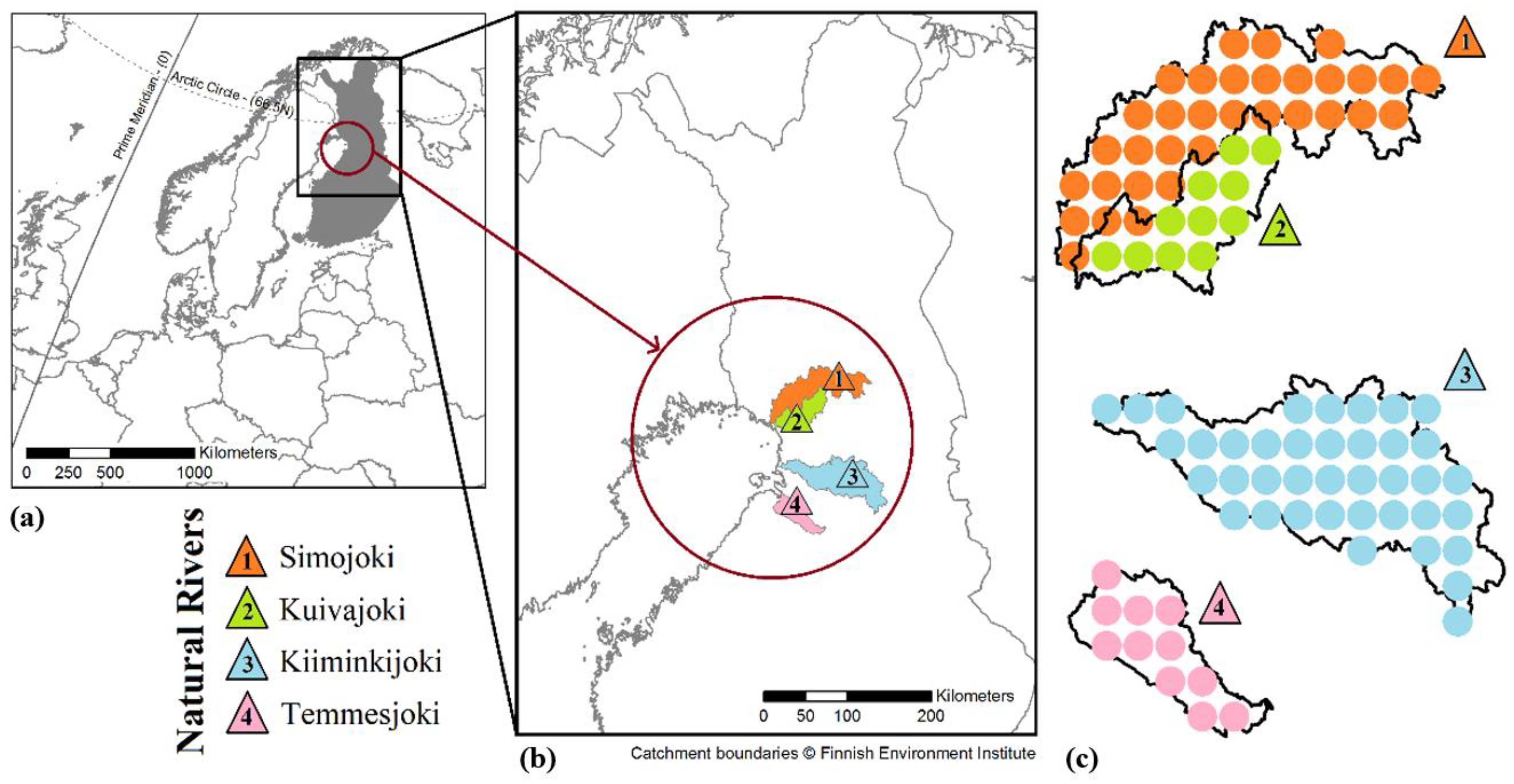
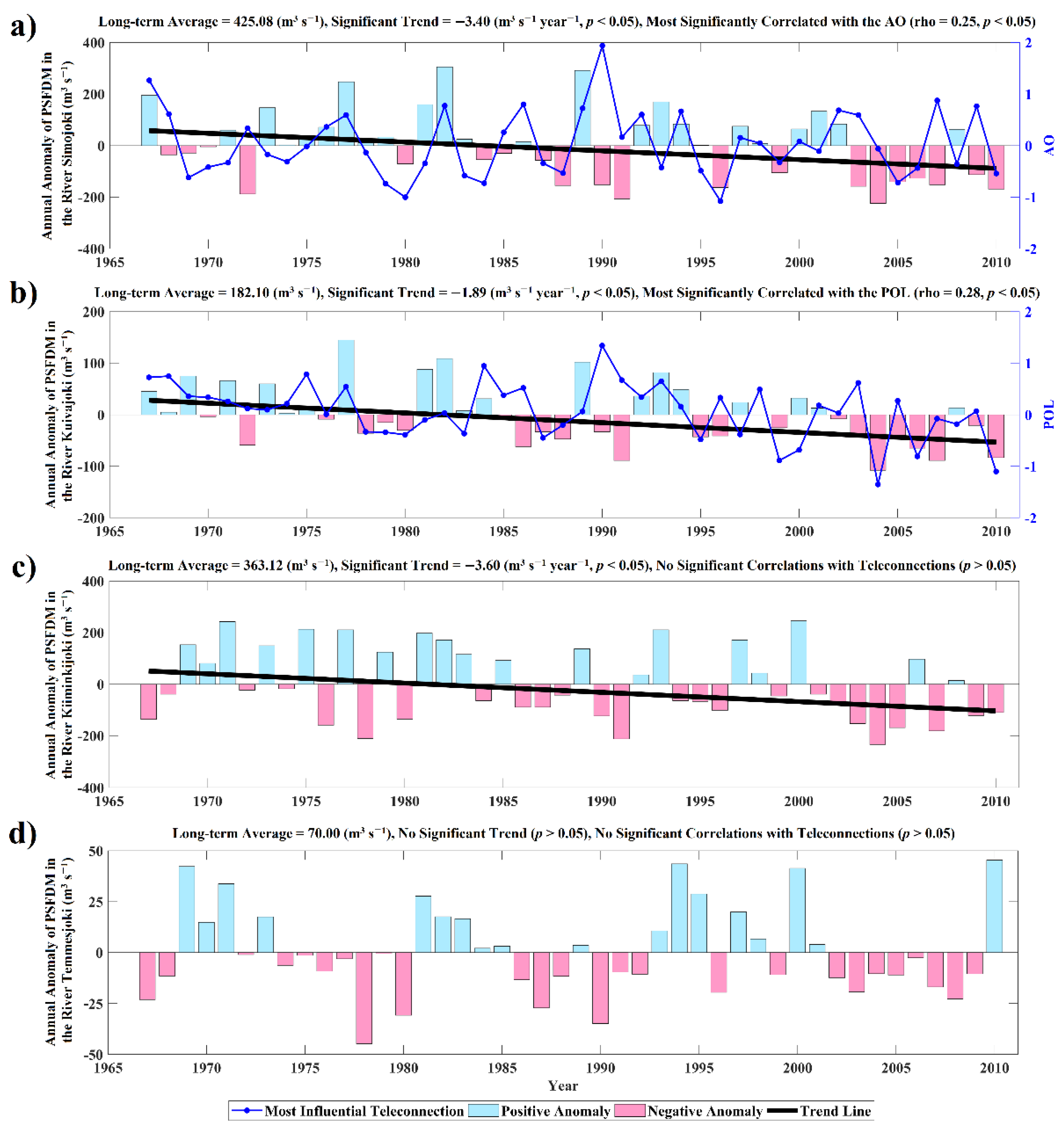
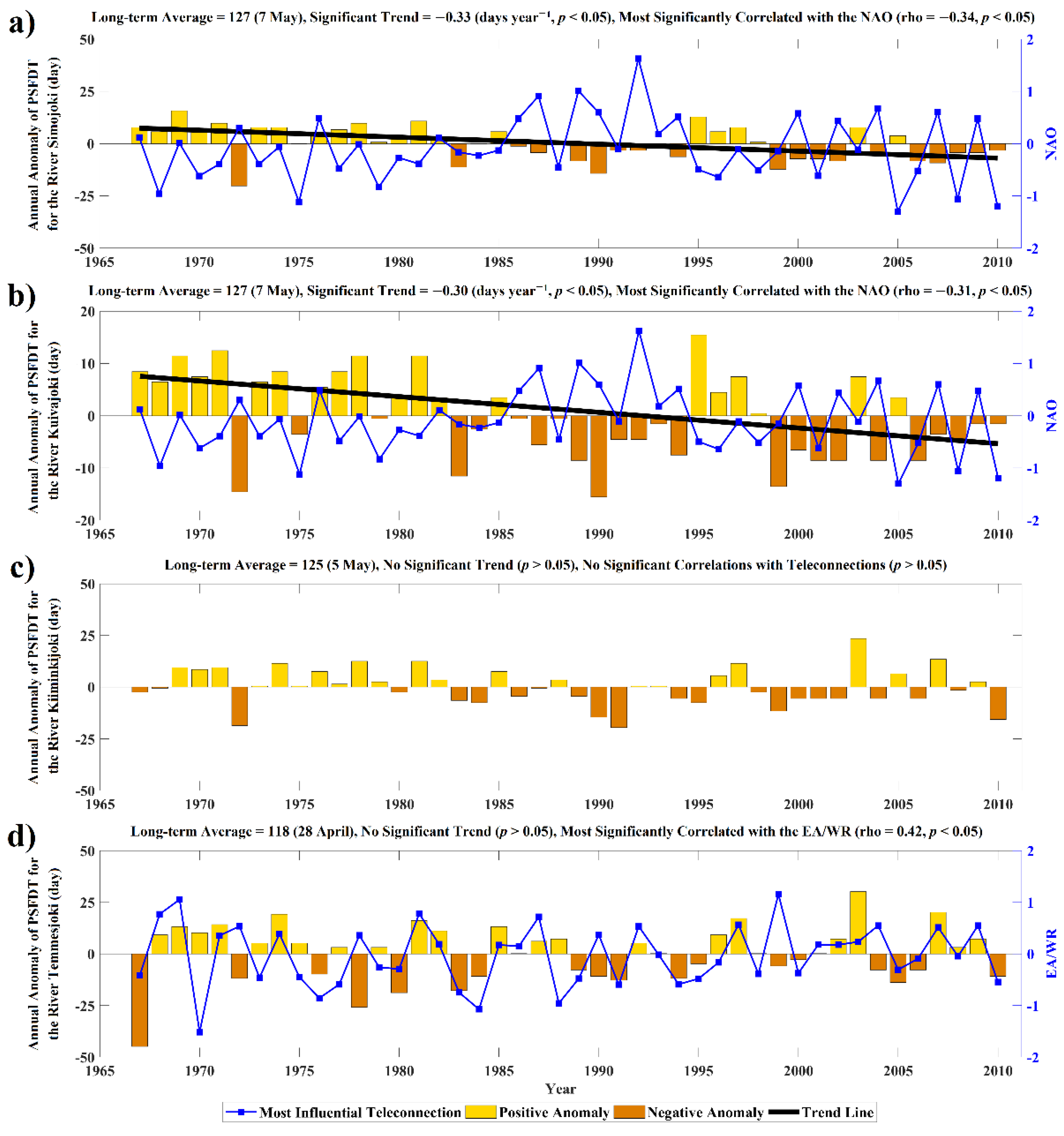

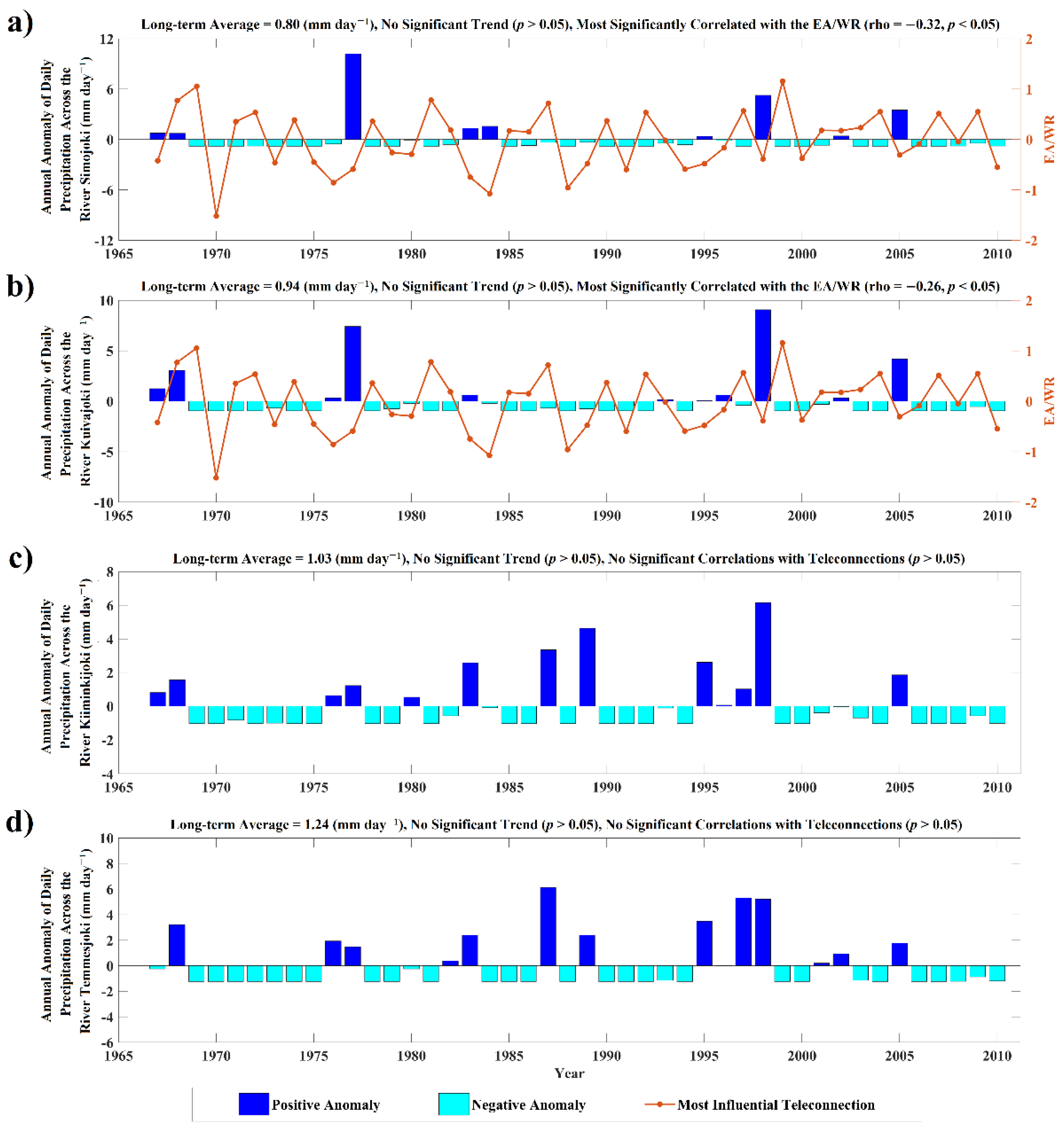
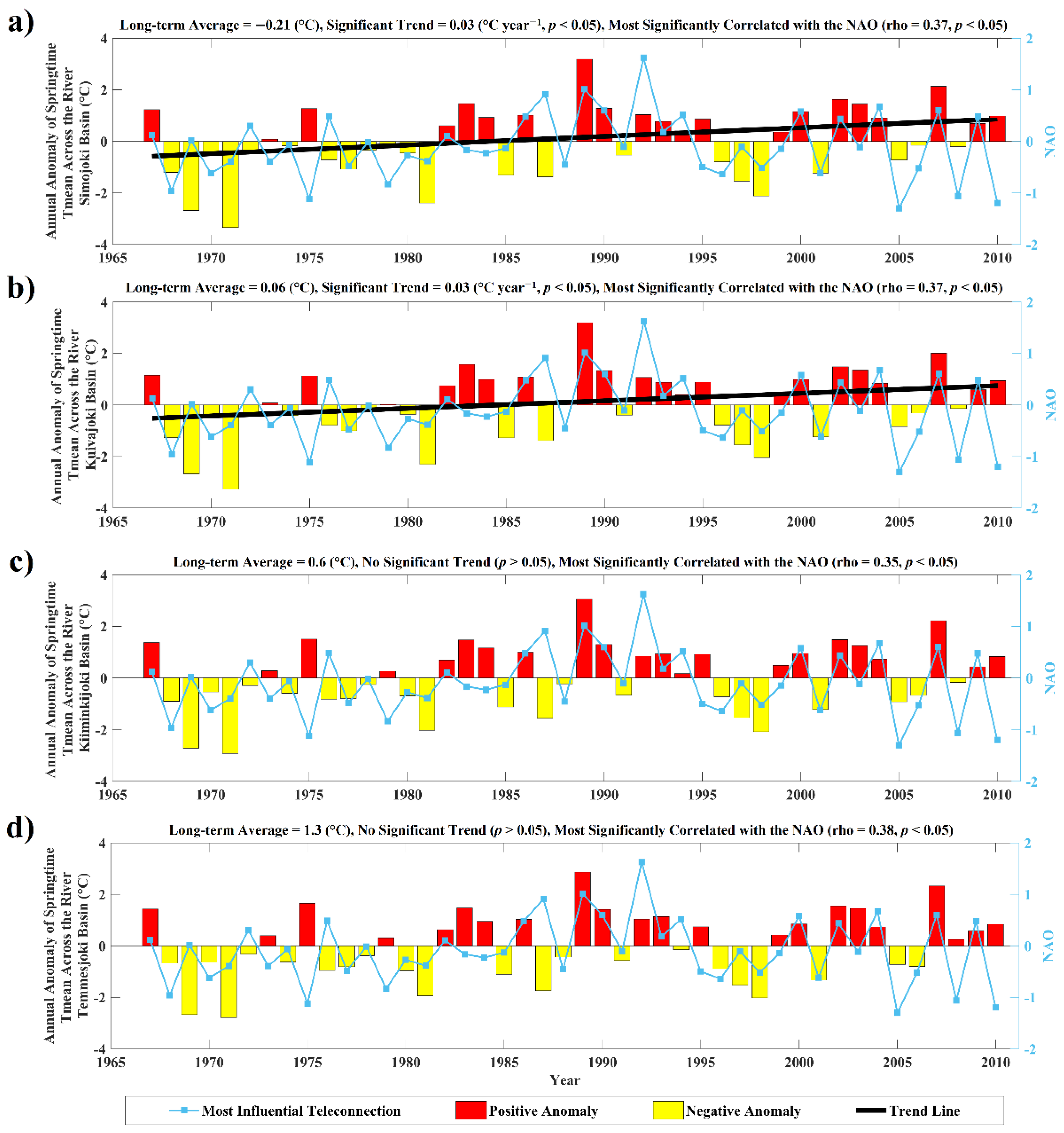
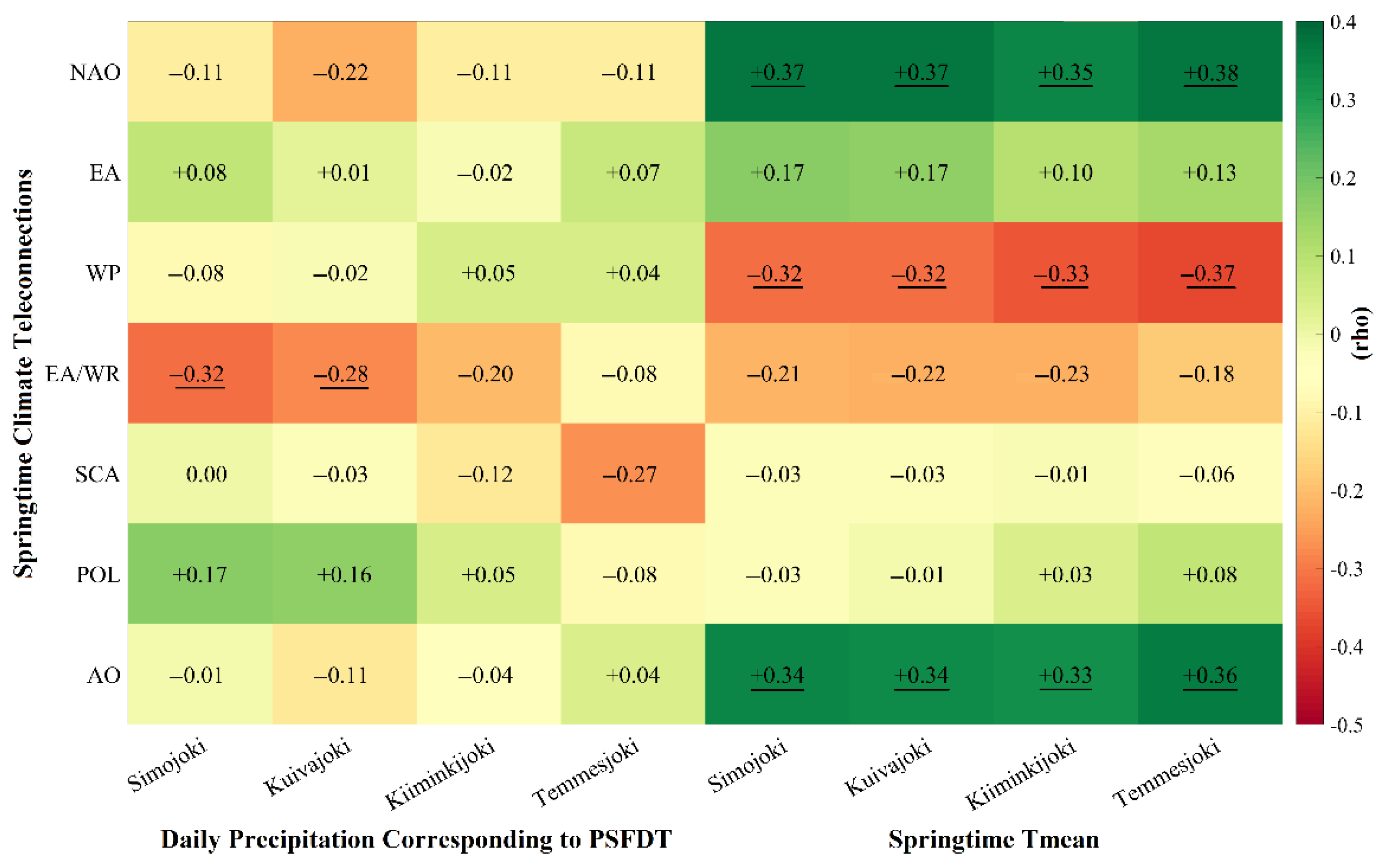

| No. | ID | Climate Teleconnection | Source | Reference |
|---|---|---|---|---|
| 1 | AO | Arctic Oscillation | CPC | [47] |
| 2 | EA | East Atlantic | CPC | [48] |
| 3 | EA/WR | East Atlantic/West Russia | CPC | [48,49] |
| 4 | NAO | North Atlantic Oscillation | CPC | [48] |
| 5 | POL | Polar/Eurasia pattern | CPC | [48] |
| 6 | SCA | Scandinavia pattern | CPC | [48,50] |
| 7 | WP | West Pacific | CPC | [51] |
Publisher’s Note: MDPI stays neutral with regard to jurisdictional claims in published maps and institutional affiliations. |
© 2022 by the authors. Licensee MDPI, Basel, Switzerland. This article is an open access article distributed under the terms and conditions of the Creative Commons Attribution (CC BY) license (https://creativecommons.org/licenses/by/4.0/).
Share and Cite
Irannezhad, M.; Ahmadian, S.; Sadeqi, A.; Minaei, M.; Ahmadi, B.; Marttila, H. Peak Spring Flood Discharge Magnitude and Timing in Natural Rivers across Northern Finland: Long-Term Variability, Trends, and Links to Climate Teleconnections. Water 2022, 14, 1312. https://doi.org/10.3390/w14081312
Irannezhad M, Ahmadian S, Sadeqi A, Minaei M, Ahmadi B, Marttila H. Peak Spring Flood Discharge Magnitude and Timing in Natural Rivers across Northern Finland: Long-Term Variability, Trends, and Links to Climate Teleconnections. Water. 2022; 14(8):1312. https://doi.org/10.3390/w14081312
Chicago/Turabian StyleIrannezhad, Masoud, Saghar Ahmadian, Amin Sadeqi, Masoud Minaei, Behzad Ahmadi, and Hannu Marttila. 2022. "Peak Spring Flood Discharge Magnitude and Timing in Natural Rivers across Northern Finland: Long-Term Variability, Trends, and Links to Climate Teleconnections" Water 14, no. 8: 1312. https://doi.org/10.3390/w14081312
APA StyleIrannezhad, M., Ahmadian, S., Sadeqi, A., Minaei, M., Ahmadi, B., & Marttila, H. (2022). Peak Spring Flood Discharge Magnitude and Timing in Natural Rivers across Northern Finland: Long-Term Variability, Trends, and Links to Climate Teleconnections. Water, 14(8), 1312. https://doi.org/10.3390/w14081312








